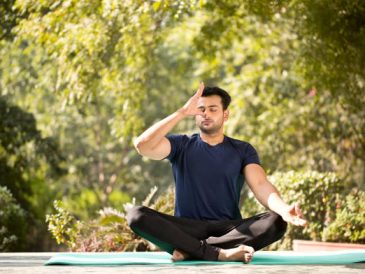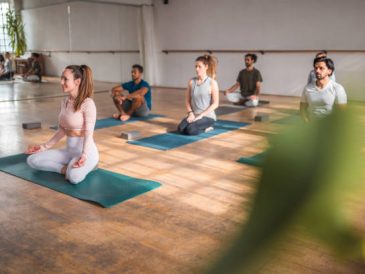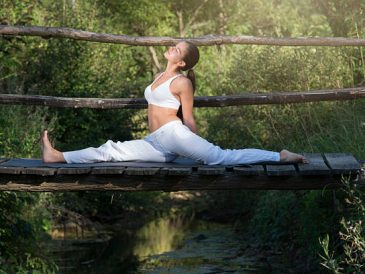The first time my teacher asked me to do an eagle pose, I thought she was kidding. I have to cross my arms in a super-awkward position that’s also an intense shoulder stretch, cross my legs in a way that makes my outer hips cry for mercy, and somehow figure out how to tuck my toes behind my calf–while balancing on one leg? And you expect me to still “breathe smoothly and evenly” while I’m at it? LOL!
But no, this pose was no joke.
Garudasana (often translated as “eagle pose,” though technically a garuda is not an eagle but a glorious mythical bird) is a challenging balance pose common in contemporary yoga classes. Whether you practice vinyasa, hot yoga, or Iyengar, you’ve encountered an eagle pose at some point in your yoga life.
Because of its prevalence, I used to assume that everyone. Still, I liked garudas and–that I was the only one attempting to time my bathroom breaks around the “balance” portion of the class, shooting dagger eyes at the teacher when she’d ask us to hold the pose for what my tight hips, crampy feet, and achy shoulders deemed way longer than necessary. I was shocked when, during a discussion with fellow teachers on our “least favorite poses,” the eagle pose ranked as the number one most dreaded asana. (Seriously, even above the chin stand!)
Although it felt good to know I wasn’t alone in my garudas ana aversion, I did want to learn to “make friends” with this pose. It might never be my favorite, but I did want to quell my urge to hightail it out of the studio every time the teacher called out “eagle”! This pose provides many benefits–including improved balance, lower-body strengthening, hip opening, and relief for an achy upper back and shoulders. All of which I could use.
For those reasons, I challenged myself to include garudas ana in my daily morning practice for a year. Although initially unpleasant, I discovered that my consistent approach made my balance feel steadier, my hips less stiff, and my shoulders less grouchy. But it wasn’t until I assisted one of my teachers during training and watched her break down the pose step by step that I started to gain an appreciation (and even genuine affection) for this asana. I began focusing on each piece of the pose and how all the details fit together instead of seeing the eagle as one big uncomfortable shape. And you know what? Garudasana is no longer my least favorite asana! (That honor now belongs solely to Chinstand).
If the eagle poses have you puzzled, or if you want to break it down a little more, here’s a quick step-by-step tutorial, along with a few helpful “yoga hacks” to help you navigate some of the trickier parts of the pose.
BREAKING IT DOWN
Step One (Set Up the Pose) Begin in (mountain pose), with your feet either together or two-fist distance (about four to six inches) apart and parallel, knees slightly bent. Some yogis prefer to start in (commonly known as chair pose) so that they sit deeply in the posture from the start. Experiment with both and see what makes the most sense for your body.
Step Two (Legs) Shift your weight into your left foot and cross your right thigh over your left. See if you can hook your right foot behind your left calf.
But what if I can’t hook my foot behind my calf? No big deal. Even if you can’t tuck your foot behind your calf, you can still get all of the fabulous balance-enhancing, lower-body-strengthening, hip-opening, and shoulder- and back-stretching benefits of garudasana. However, if you want to hook your toes behind your standing leg shin, but it feels just out of reach, you might find that the following tip does the trick:
Use your right hand to move your right (top leg) and sit your bone up and out to the side; this creates more space and accessibility in hooking your leading foot behind your standing leg shin. Once your foot is in place, draw your right hip crease back to re-level your pelvis.
Step Three (Arms) Next, cross your left elbow over your right (like you’re hugging yourself) and bring the palms of your hands (or the backs of your hands) together.
Step Four (Refine) Hug your legs together, and sit back in a chair pose. Lift your elbows to shoulder height, and settle the heads of your arm bones back toward your shoulder sockets. Maintain that, and reach your hands forward, away from you, to create more stretch between your upper shoulder blades. Relax your face and your jaw. You can remain standing upright–or, if you feel stable, bow forward and bring your bottom elbow to your top knee.
Variation: Foot on Block To help with balance, rather than tucking your top foot behind your calf or letting it hang, rest the ball of the top-leg foot on a yoga block.
Challenge: Same Arm as Leg Garudasana is most often taught with the opposite arm as a leg on top (if the right leg is on top, the left arm is on top, and vice versa). But when taking class with my teacher (and YI contributor), Sandra Anderson, I noticed that she taught the pose with the same arm as a leg on top (if the right leg is on top, the right arm is on top, and vice versa). This seemed more challenging, balance-wise.
Curious, I asked her why she taught the pose this way, and her answer was pretty intriguing and a great reminder of the deeper, more subtle aspects of asana:
“Practicing garudas ana with the opposite arm (to leg) on top does make it easier to balance,” she explains. “I teach it the other way, with the same side on top, because that’s how I was taught. It also seems that in this pose, as in all the asymmetrical postures, you move energy from one side to the other at a profound level. This is indicated by the switch of nostril dominance, which you can experience in these [asymmetrical] poses if your system is clear and balanced and your awareness is sensitive. So practicing garudas ana this way is like lying on your left side to open the right nostril when the left arm and leg are under the right and being squeezed. Of course, the right nostril opens by pressuring the left armpit, so perhaps it doesn’t matter what the legs do–except that squeezing them together can activate the pelvic floor (closing off the downward flowing energy, apana). I also like feeling one whole side free and open and the other whole side compressed. It feels more congruent with that bilateral shift that happens through the whole body, including the brain’s hemispheres.”
The Big Picture Overall, whether you support your foot with a block or wrap it behind the opposite leg–whether you’re crossing the same arm, same leg (as Sandy instructs garudas ana) or working with the opposite arm, opposite leg–the most important thing to remember about eagle (and any asana) is to adapt and practice it in a way that best serves you, your body, and your intentions for practice.




